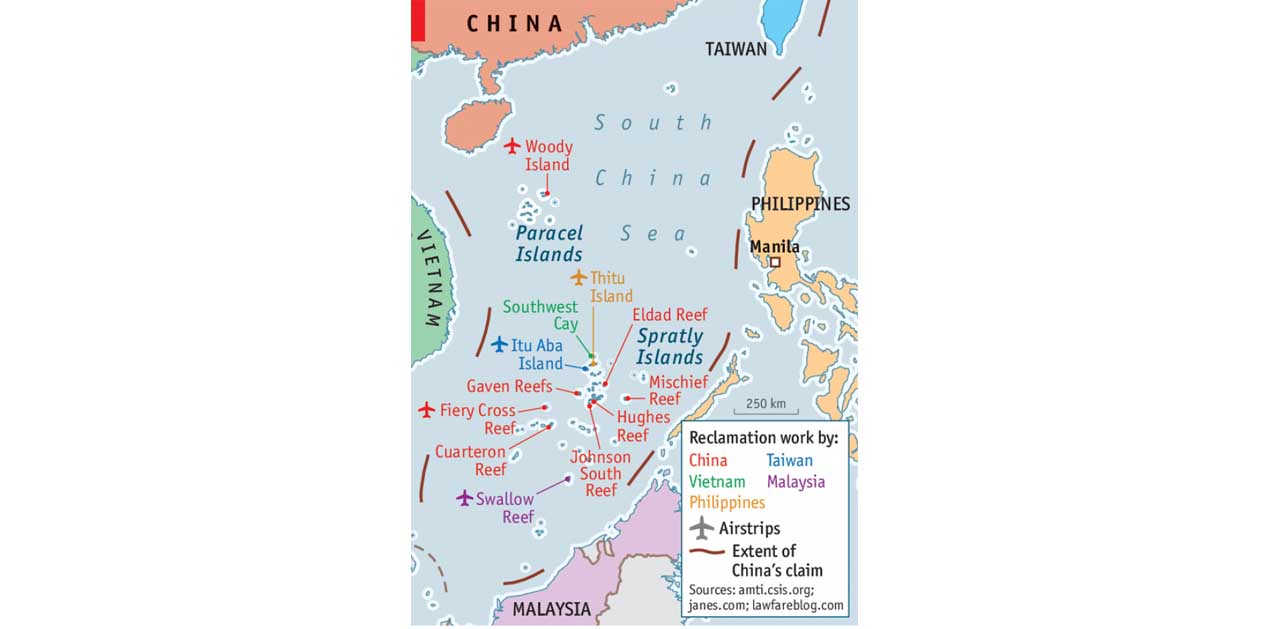China has been looking into formalizing of a Code of Conduct (COC) for the South China Sea (SCS) and seeks a possible long lasting solution to the maritime territorial dispute that persists with its other claimant countries. There have been consultative mechanisms under the ASEAN process as well as bilateral interactions at play to solve the SCS issue. Further, China has proposed maritime cooperation as well as undertaking of joint development projects in the contentious region. China has proposed that it can undertake oil and gas exploration and create implementable standard operating procedures for development of the region.
With regard to fishing, mineral and exploration of other resources, it claims that it abides by the UNCLOS and assures freedom of navigation as well as peace and stability in the region. However, Beijing had made it very clear that joint exploration of oil and gas resources would only be undertaken in the non- contentious regions such as the Reed Bank. The reflections from the Chinese side have been primarily focused on the fact that involvement of extra-regional powers has aggravated tensions and also created problems for the solution of the SCS issue in a time bound manner.
In the last ASEAN foreign ministers meeting held in August 2018, it was announced that a single draft on SCS COC Negotiating Text has been agreed to which will be a basis for the Code. The draft also includes paragraphs and articles along with select reservations of all the claimant states. It would be the responsibility of the contending parties to work out a regionally acceptable solution, whereas China has declared that it would be making every necessary effort so that the issue gets resolved within a time period of three years. Adding a caveat, Chinese scholars have confirmed that COC would not in any way mean that the territorial and maritime disputes would be resolved with the signing of COC. China has still insisted on resolving the maritime disputes through bilateral mechanisms and consultations.
Giving example of its resolution of maritime boundary with Vietnam in the Gulf of Tonkin and Beibu Bay, Chinese scholars aver that similar template can be utilized by other claimant states. Discussions within the Chinese think tanks show that according to their perspective, the involvement of the extra regional powers such as Japan, US and Australia, has led to further militarization and also a sense of insecurity among other regional countries. China has also made it clear that during the period 2013-2016 when the Permanent Court of Arbitration (PCA) was adjudicating the Philippines case, the SCS was unstable, and there had been numerous incidents giving rise to tensions. Chinese scholars have believed that there would be a drastic change in developments in SCS when the draft COC is formalized into an agreement and the claimant countries act in a very responsible manner.
Many of the Chinese scholars feel that the challenge of prolonged consultations with regard to territorial issues about Spratly Islands would create new trends of conflict between the nations. Even lately, the military tensions between US and China was triggered by increasing US aerial surveillance and frequent visits by US warships to Vietnam, Philippines and other areas of contested region which have led to increased military confrontation and competition. During the interactions with the Chinese scholars, the common opinion was that SCS was not about strategic contest but a pure geopolitical interest. There have never been concerns with regard to freedom of navigation and rules based order. Competition with US primarily is with regard to structural edifice that is increasingly becoming irreconcilable. The US perceives that China’s construction activities in the contentious region of SCS are purely aimed at controlling it. This has been the main reason of aggravation of tensions between US and China.
Further, Chinese scholars believe that other US allies such as Japan and Australia have been following the US stance and have been conducting provocative actions. Chinese scholars alluded to the fact that in May 2017 and during the period between August to October 2018, Japan had sent it Maritime Self Defense Forces (MSDF) to contact operations in SCS. According to them, the US has also cajoled India and Australia to resist Chinese activities in the Indian Ocean Region and that US allies - Japan and Australia - have been using tensions in the SCS and Chinese militarization as an alibi to increase their footprints in that Sea.
In such a scenario misinterpretation and hostile actions would lead to maritime conflicts. China has very recently conducted naval drills with the SCS claimant countries, and it is viewed by them as a part of its cooperative action plan. Chinese think tanks believe that the situation is peaceful in SCS, but in future there will be skirmishes as well as tension in case difficult scenarios emerge with extra regional powers engaging in destabilizing efforts. Chinese scholars believe that there are four reasons for flare up in SCS and this includes military maneuvers by the US, COC consultations with external prompting, development of facilities and military deployment by other claimant states, and at time unilateral action by few states in the disputed area.
On being asked as to what are the precise coordinates of their so called ‘Nine Dash’ line, the Chinese interlocutors are not very forthcoming and state that giving out such location would only intensify the existing complications and tensions.
While India takes no position on the sovereignty issues in the SCS, it supports freedom of navigation and overflight and peaceful resolution of the disputes. The SCS remains of interest to India because over 50 percent of India’s trade passes through the SCS.
In the conclusion, the Chinese stance in SCS, according to their thought process, rests on five major pillars. Firstly, to maintain peace and stability in SCS; secondly, to resolve the SCS imbroglio and address issues related to sovereignty and maritime boundary; thirdly, to protect and safeguard freedom of navigation; fourthly, to promote joint development of resources; and lastly, to adopt a dual approach under which China and ASEAN countries would maintain peace and security in the SCS.
Obviously, this perspective is at variance from most of the ASEAN countries and other major powers in the region. Largely, they remain wary of China’s offer of joint development of SCS resources and are looking for a legally binding COC which has not fructified as yet. Though China’s Foreign Minister Wang Yi has stated that Beijing will strictly adhere to the COC whether it is legally binding or not yet, such articulations are viewed skeptically by other signatories to the COC.
Image Source: https://www.economist.com/sites/default/files/imagecache/640-width/images/print-edition/20150228_ASM934.png











Post new comment